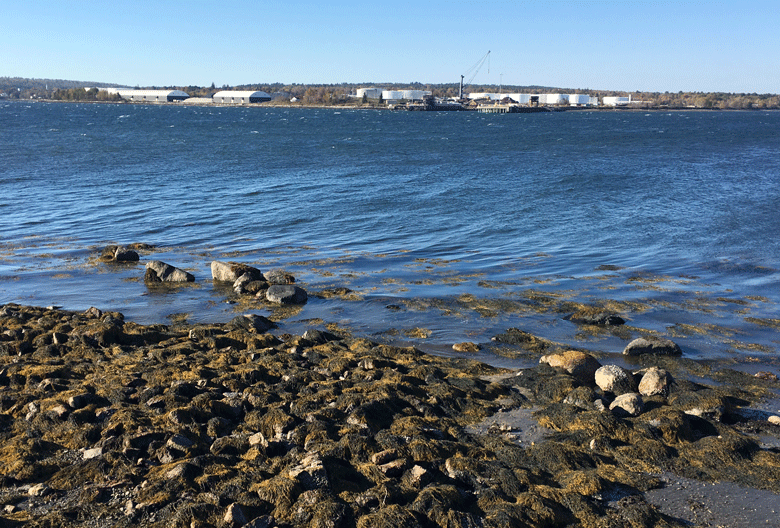After years of deliberating on the best site to establish a port to service a planned offshore wind turbine array, Gov. Janet Mills announced Feb. 20 that the facility would be built on Sears Island in Searsport.
Port facilities in Portland and Eastport were under consideration, as was Mack Point on the mainland in Searsport. A hybrid plan that would have included both the existing piers at Mack Point and a new facility on Sears Island also was considered.
State officials asserted that a new “purpose-built port facility” on Sears Island would establish Maine’s place in the growing offshore wind industry and become a hub for job creation and economic development.
“The most feasible port development site in terms of location, logistics, cost, and environmental impact…”
The land portion of the facility would allow for floating offshore wind fabrication, staging, assembly, maintenance, and deployment, which would have the turbines towed to their mooring sites. There is deep water access adjacent to Sears Island.
The array is proposed to include 10–12 turbines on semi-submersible floating concrete platforms, designed by the University of Maine’s Advanced Structures and Composite Center.
The site selection process was led by the Department of Transportation and Maine Port Authority, with the state concluding that the Sears Island parcel is “the most feasible port development site in terms of location, logistics, cost, and environmental impact,” according to its announcement.
Advocacy groups, including the Friends of Sears Island and Islesboro Islands Trust, have expressed their opposition to the proposal, arguing that Mack Point would be a better choice. Mack Point, now owned and operated by Sprague Energy, has hosted port infrastructure for more than 200 years. It is about 500 yards from the site selected on Sears Island.
Environmental groups supporting the project include the Natural Resources Council of Maine, Maine Conservation Voters, and Maine Audubon, though the Audubon group did not indicate its support for Sears Island as a preferred site for the port. Labor groups have also endorsed the Sears Island choice.
Sears Island is a 941-acre state-owned island off the coast of Searsport, joined to the mainland by a causeway built in the late 1980s in anticipation of a container port being built there. Gov. Angus King reluctantly scrapped that proposal in 1996.
The container port was one of a half-dozen industrial proposals, which included nuclear power plants, an aluminum smelter, coal gasification plant, and a liquefied natural gas port.
After a lengthy stakeholder negotiation process, the island was divided in 2009 into two parcels: approximately 601 acres, or two-thirds of the island, was placed in a permanent conservation easement held by the Maine Coast Heritage Trust, while the remaining one-third, or approximately 330 acres, was reserved by DOT for future development.
The site for the wind port is about 100 acres, which is about one-third of the transportation-reserved parcel, and a little more than one-tenth of the entire island. The estimated construction cost is $500 million, with funding likely to be sought from federal sources.
Last year, Mills signed legislation to advance offshore wind in Maine by aiming to develop up to 3,000 megawatts of offshore wind energy in federal waters.
“This was not an easy decision, nor is it one that I made lightly,” Mills said of the site choice. “For more than two years, my administration has evaluated Sears Island and Mack Point thoroughly and with an open mind, recognizing that each site has its own set of benefits and its own set of drawbacks.”
The governor acknowledged that the island, which has recreational trails developed by the Friends group, “is enjoyed by many people.”
Former Islesboro Select Board chairman Arch Gillies said he was “profoundly disappointed in the governor’s breach of the state’s commitment” to prioritize Mack Point over Sears Island.
Islesboro Islands Trust said it would intervene “using every legal means available.” The group supports offshore wind “but affirms that the offshore wind manufacturing facility should be built at Mack Point,” according to a statement it issued after the site was selected.
Mack Point consolidates industry in one location, economizes on existing infrastructure, and replaces and remediates Mack Point’s brownfield history, the Islesboro group noted. It also said that construction costs at both sites were close to equal and that a rail line is available at Mack Point.
Dan Burgess, director of the Governor’s Energy Office, said a port “is a critical step … supporting the generation of clean, affordable, reliable energy for Maine and the region.”
Matthew Burns, executive director of the Maine Port Authority, said “Our heritage as a seafaring state makes perfect sense for utilizing one of Maine’s best assets, its deep-water ports.”
David Gelinas, president of the Penobscot Bay & River Pilots Association, noted that Sears Island “will minimize impacts from southerly winds and seas, while providing safe shelter for smaller vessels that will be necessary to service the port,” and offers the most direct approach in and out of the Searsport navigation channel and allows the existing docks at Mack Point to continue accommodating vessels.





